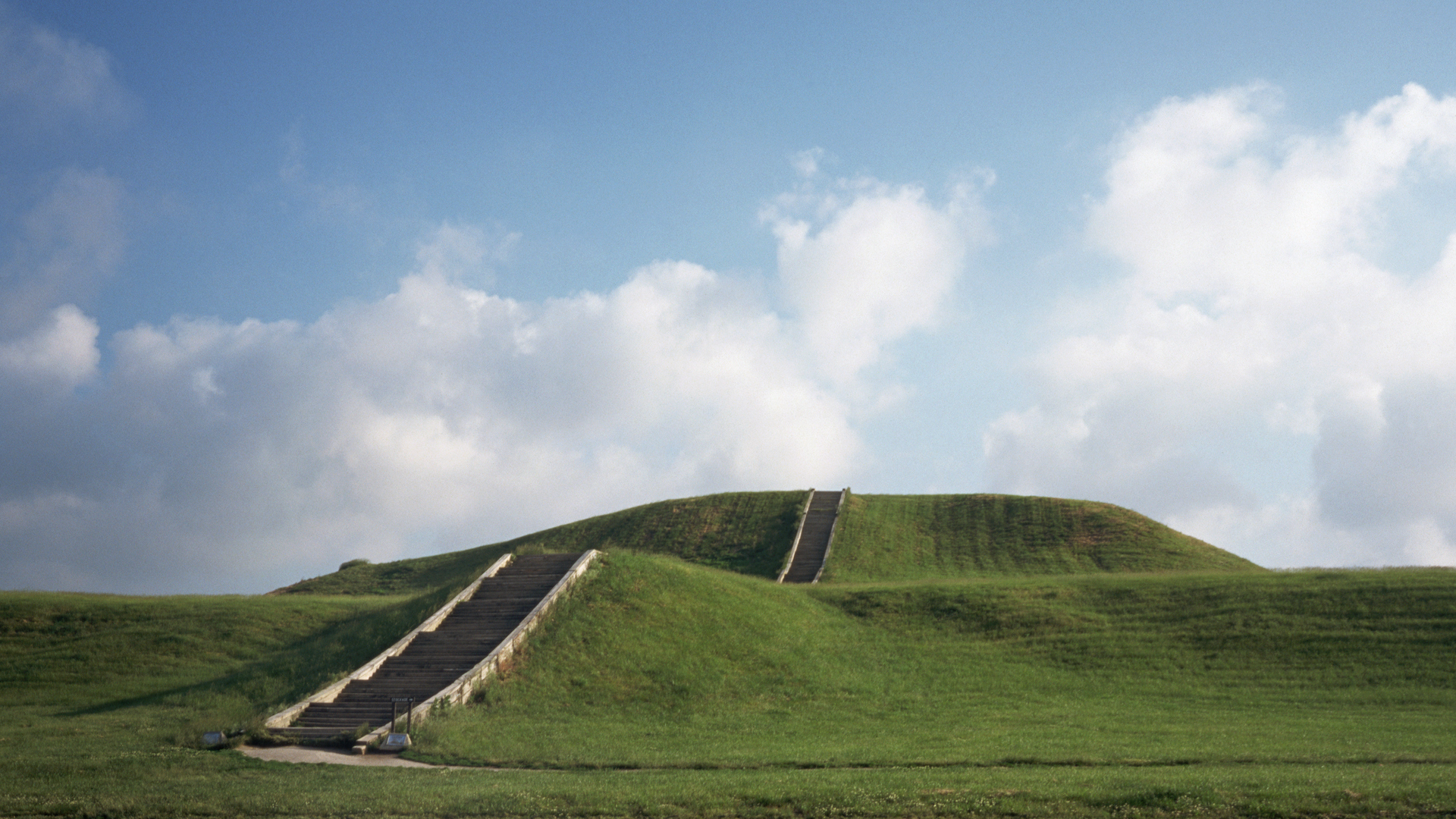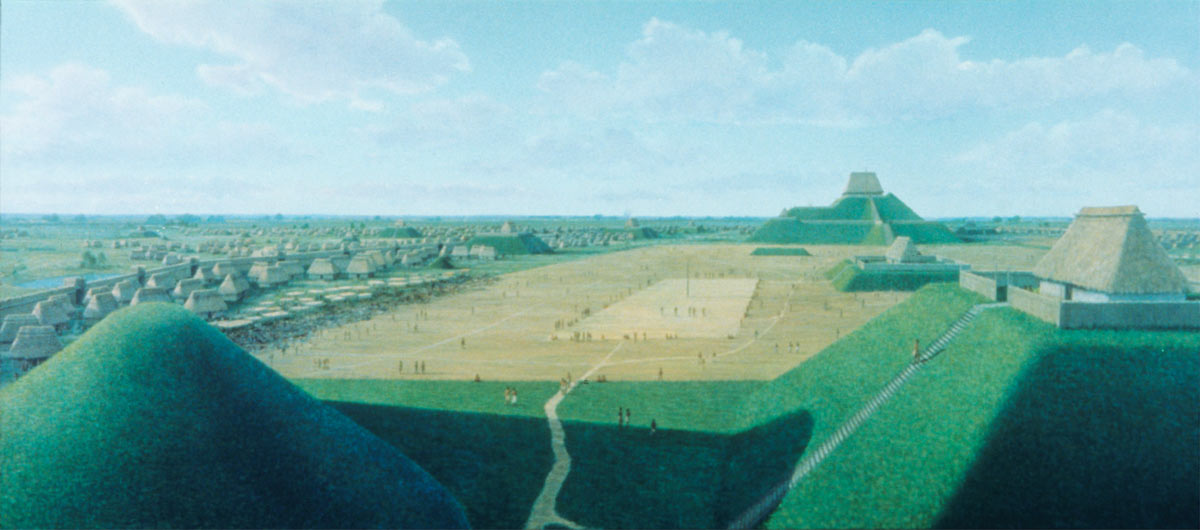Cahokia: One of the 1st cities in North America
Cahokia was the largest pre-Columbian city in North America, and at its peak, the metropolis near modern-day St. Louis was bigger than London.

Cahokia was a city that, at its peak from A.D. 1050 to 1200, was larger than many European cities, including London. The city was spread out over 6 square miles (16 square kilometers), encompassed at least 120 mounds, and had a population of 10,000 to 20,000.
Located across the Mississippi River from modern-day St. Louis, Cahokia was the largest pre-Columbian city north of Mexico. The inhabitants of Cahokia did not use a writing system, and researchers today rely heavily on archaeology to interpret it. The name of the people who built the mounds is lost to time, so the city was named for the Cahokia Indigenous people who lived in the area during the 17th century, but who are not related to its original inhabitants, according to the Oklahoma Historical Society.
Cultural finds from the city include evidence of a popular game called "Chunkey" and a caffeine-loaded drink. Artistic finds include stone tablets carved with images (such as a birdman), as well as evidence of sophisticated copper working, including jewelry and headdresses.
The city's growth may have been aided by warmer temperatures. At the time Cahokia flourished, temperatures across the planet were unusually warm, resulting in increased rainfall in the American Midwest, archaeologists Timothy Pauketat and Susan Alt wrote in an article in the book "Medieval Mississippians: The Cahokian World" (School for Advanced Research Press, 2015). "An increase in average yearly precipitation accompanied the warmer weather, permitting maize farming to thrive," Pauketat and Alt wrote.
Why did Cahokia fall?
Cahokia declined after 1200, around the time of a flood, and was abandoned by 1400. It's unclear why the city fell, but one idea was that its residents left after a prolonged drought caused a massive crop failure. However, a 2024 study in the journal The Holocene debunked this idea by looking at historical carbon isotopes in the soil, or carbon atoms that have a different number of neutrons in their nuclei. The carbon isotopes revealed that the plants at Cahokia stayed consistent, even through the drought.
"We saw no evidence that prairie grasses were taking over, which we would expect in a scenario where widespread crop failure was occurring," study co-author Natalie Mueller, an assistant professor of archaeology at Washington University in St. Louis, said in a statement.
It's likely that the people of Cahokia had engineering or irrigation skills to survive the drought, the researchers said. The city likely had a storage system for grains, and the people probably ate fish, birds, deer, bear, and forest fruits and nuts, Mueller added.
Much of the city lies buried under 19th- and 20th-century developments, including a highway and the city of St. Louis. Over the past few decades, there have been efforts to preserve the remains, and Cahokia's core is now part of a state historic site.
Mounds of Cahokia: Monks Mound

The best example of architecture at Cahokia is the 100-foot-tall (30 meters) "Monks Mound," so named because a group of Trappist monks lived near it in historic times.
The mound, which towered over the city, was built with four terraces and covered about 17 acres (6.8 hectares) at its base. Archaeologists have found giant postholes at the top indicating what may have been a temple, presumably made of wood, measuring 104 feet (31 m) by 48 feet (15 m). The postholes are over 3 feet (1 m) in diameter, and the building would have been about 50 feet (15 m) tall.
Monks Mound, along with a grand plaza and a group of smaller mounds, was walled in with a 2-mile-long (3.2 km) wooden palisade. As many as 20,000 wooden posts were used to construct it.
Get the world’s most fascinating discoveries delivered straight to your inbox.
Woodhenge at Cahokia
To the west of Monks Mound is a series of five circles, each originally made of red cedar wood posts and constructed at different times between A.D. 900 and 1100. They vary in size from 12 to 60 posts, and the latest one is the smallest. Archaeologists refer to these structures as a "woodhenge," and a reconstruction of it was made in 1985.
These posts likely would have served as a calendar to mark the solstices, equinoxes and festivals that were important to the inhabitants. A priest could have stood on a platform in the middle.
The sunrise during the equinox, when it rises to the east, is said to be particularly spectacular from this spot. A post aligns with the front of Monks Mound, and the massive structure looks like it "gives birth" to the sun, according to a modern account recorded on the Cahokia Mounds State Historic Site.
Human sacrifice at Cahokia
Mound 72 is a 10-foot-high (3 m) structure located less than a half mile (0.8 km) south of Monks Mound. It dates to between 1050 and 1150 and holds the remains of 272 people, many of whom were sacrificed — the largest number of sacrificial victims ever found north of Mexico.
The mound's archaeology is complicated, but several instances of human sacrifice can be inferred. In one case, 39 men and women were executed "on the spot," Pauketat wrote in the book "Cahokia: Ancient America's Great City on the Mississippi" (Penguin, 2010). "It seemed likely the victims had been lined up on the edge of the pit ... and clubbed one by one so that their bodies fell sequentially into it."
In another episode of sacrifice, 52 malnourished women between the ages of 18 and 23 appear to have been sacrificed at the same time, along with a woman in her 30s. It's not known why these women were sacrificed. An analysis of the women's teeth indicated that many of the women were from the local area, suggesting they were not captured during a war.
The burial mound also has the remains of a man and a woman who were found buried with 20,000 shell beads, likely from the remains of garments. They may have been a couple with significant power. Near those individuals' remains, archaeologists found the burials of 12 other people, including several male-female couples and a child.
Cosmology at Cahokia

The absence of written records makes it difficult for researchers to understand the religious and spiritual beliefs of Cahokia's residents. However, "new evidence suggests that the central Cahokia precinct was designed to align with calendrical and cosmological referents — sun, moon, earth, water and the netherworld," archaeologists wrote in a 2017 study in the journal Antiquity.
For instance, a place that archaeologists call the "Emerald Acropolis" marks "the beginning of a processional route" that leads to central Cahokia. At least 12 mounds and the remains of wooden buildings, some of which were likely used as "shrines," have been identified at this acropolis, the archaeologists wrote in the journal article, noting that the mounds and wooden buildings have "lunar alignments."
Additionally, water may have played a role in the rituals performed at the acropolis. Some of the buildings were ritually "closed" with "water-redeposited silts" put over them, the archaeologists wrote. In a few cases, mats or hides were burned inside the buildings, and then silt was put over them. A burial of an infant was found in one of the buildings and may have been placed inside as an "offering," the team wrote.
Chunkey
Cahokia supported a rich variety of art and cultural activities, including a wildly popular game called "Chunkey."
Archaeologists aren't sure of the exact rules during Cahokia's peak. Accounts of the game in the 18th and 19th century tell of a stone disc, called a "chunkey stone," that would be rolled on a playing field. People would throw giant sticks larger than themselves at it, trying to land them as close to the stone as possible. Points would be given depending on how close they came. Gambling on the outcome of this game was common, according to 18th- and 19th-century writers.
Pauketat envisions Chunkey being played as a team sport in the plaza beside Monks Mound. As he described in an Archaeology magazine article, "The chief standing at the summit of the black, packed-earth pyramid raises his arms. In the grand plaza below, a deafening shout erupts from 1,000 gathered souls. Then the crowd divides in two, and both groups run across the plaza, shrieking wildly. Hundreds of spears fly through the air toward a small rolling stone disk ..." Spectators would cheer them on, witnessing a great sport that captivated the North American city.
Editor's note: This article was originally published on Jan. 11, 2018, and was updated on Sept. 26, 2024, to include information about Cahokia's drought.
Additional resources
Learn more about this archaeological site at Cahokia Mounds State Historic Site. See why the United Nations added it to its UNESCO World Heritage list. And dive into the "big history" of Cahokia with the University of Illinois Urbana-Champaign.

Owen Jarus is a regular contributor to Live Science who writes about archaeology and humans' past. He has also written for The Independent (UK), The Canadian Press (CP) and The Associated Press (AP), among others. Owen has a bachelor of arts degree from the University of Toronto and a journalism degree from Ryerson University.
